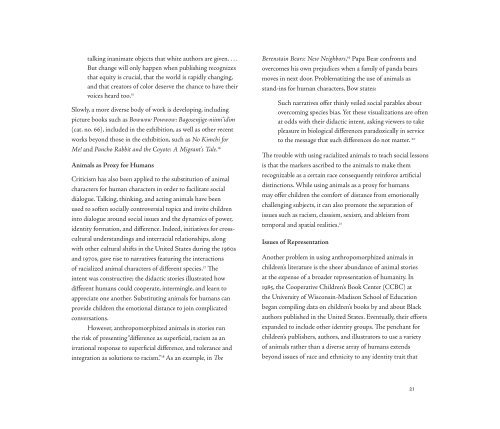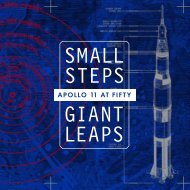Animals Are Us: Anthropomorphism in Children’s Literature; Celebrating the Peter J. Solomon Collection
Why do we tell stories to children through and about animals? Are there reasons why we shouldn’t? Animals Are Us invites explores these questions and more through influential historic examples of anthropomorphism in dialogue with contemporary books drawn from the collection of Peter J. Solomon (Harvard College Class of 1960, MBA 1963) and the holdings of Houghton Library. The exhibition invites you to engage critically with animal anthropomorphism, and delight in the artfulness of this enduring literary genre. Catalog of an exhibition on view at Houghton Library, Harvard University, September 1, 2021 - January 7, 2022.
Why do we tell stories to children through and about animals? Are there reasons why we shouldn’t? Animals Are Us invites explores these questions and more through influential historic examples of anthropomorphism in dialogue with contemporary books drawn from the collection of Peter J. Solomon (Harvard College Class of 1960, MBA 1963) and the holdings of Houghton Library. The exhibition invites you to engage critically with animal anthropomorphism, and delight in the artfulness of this enduring literary genre.
Catalog of an exhibition on view at Houghton Library, Harvard University, September 1, 2021 - January 7, 2022.
Create successful ePaper yourself
Turn your PDF publications into a flip-book with our unique Google optimized e-Paper software.
talk<strong>in</strong>g <strong>in</strong>animate objects that white authors are given. . . .<br />
But change will only happen when publish<strong>in</strong>g recognizes<br />
that equity is crucial, that <strong>the</strong> world is rapidly chang<strong>in</strong>g,<br />
and that creators of color deserve <strong>the</strong> chance to have <strong>the</strong>ir<br />
voices heard too. 15<br />
Slowly, a more diverse body of work is develop<strong>in</strong>g, <strong>in</strong>clud<strong>in</strong>g<br />
picture books such as Bowwow Powwow: Bagosenjige-niimi’idim<br />
(cat. no. 66), <strong>in</strong>cluded <strong>in</strong> <strong>the</strong> exhibition, as well as o<strong>the</strong>r recent<br />
works beyond those <strong>in</strong> <strong>the</strong> exhibition, such as No Kimchi for<br />
Me! and Pancho Rabbit and <strong>the</strong> Coyote: A Migrant’s Tale. 16<br />
<strong>Animals</strong> as Proxy for Humans<br />
Criticism has also been applied to <strong>the</strong> substitution of animal<br />
characters for human characters <strong>in</strong> order to facilitate social<br />
dialogue. Talk<strong>in</strong>g, th<strong>in</strong>k<strong>in</strong>g, and act<strong>in</strong>g animals have been<br />
used to soften socially controversial topics and <strong>in</strong>vite children<br />
<strong>in</strong>to dialogue around social issues and <strong>the</strong> dynamics of power,<br />
identity formation, and difference. Indeed, <strong>in</strong>itiatives for crosscultural<br />
understand<strong>in</strong>gs and <strong>in</strong>terracial relationships, along<br />
with o<strong>the</strong>r cultural shifts <strong>in</strong> <strong>the</strong> United States dur<strong>in</strong>g <strong>the</strong> 1960s<br />
and 1970s, gave rise to narratives featur<strong>in</strong>g <strong>the</strong> <strong>in</strong>teractions<br />
of racialized animal characters of different species. 17 The<br />
<strong>in</strong>tent was constructive; <strong>the</strong> didactic stories illustrated how<br />
different humans could cooperate, <strong>in</strong>term<strong>in</strong>gle, and learn to<br />
appreciate one ano<strong>the</strong>r. Substitut<strong>in</strong>g animals for humans can<br />
provide children <strong>the</strong> emotional distance to jo<strong>in</strong> complicated<br />
conversations.<br />
However, anthropomorphized animals <strong>in</strong> stories run<br />
<strong>the</strong> risk of present<strong>in</strong>g “difference as superficial, racism as an<br />
irrational response to superficial difference, and tolerance and<br />
<strong>in</strong>tegration as solutions to racism.” 18 As an example, <strong>in</strong> The<br />
Berensta<strong>in</strong> Bears: New Neighbors, 19 Papa Bear confronts and<br />
overcomes his own prejudices when a family of panda bears<br />
moves <strong>in</strong> next door. Problematiz<strong>in</strong>g <strong>the</strong> use of animals as<br />
stand-<strong>in</strong>s for human characters, Bow states:<br />
Such narratives offer th<strong>in</strong>ly veiled social parables about<br />
overcom<strong>in</strong>g species bias. Yet <strong>the</strong>se visualizations are often<br />
at odds with <strong>the</strong>ir didactic <strong>in</strong>tent, ask<strong>in</strong>g viewers to take<br />
pleasure <strong>in</strong> biological differences paradoxically <strong>in</strong> service<br />
to <strong>the</strong> message that such differences do not matter. 20<br />
The trouble with us<strong>in</strong>g racialized animals to teach social lessons<br />
is that <strong>the</strong> markers ascribed to <strong>the</strong> animals to make <strong>the</strong>m<br />
recognizable as a certa<strong>in</strong> race consequently re<strong>in</strong>force artificial<br />
dist<strong>in</strong>ctions. While us<strong>in</strong>g animals as a proxy for humans<br />
may offer children <strong>the</strong> comfort of distance from emotionally<br />
challeng<strong>in</strong>g subjects, it can also promote <strong>the</strong> separation of<br />
issues such as racism, classism, sexism, and ableism from<br />
temporal and spatial realities. 21<br />
Issues of Representation<br />
Ano<strong>the</strong>r problem <strong>in</strong> us<strong>in</strong>g anthropomorphized animals <strong>in</strong><br />
children’s literature is <strong>the</strong> sheer abundance of animal stories<br />
at <strong>the</strong> expense of a broader representation of humanity. In<br />
1985, <strong>the</strong> Cooperative <strong>Children’s</strong> Book Center (CCBC) at<br />
<strong>the</strong> University of Wiscons<strong>in</strong>-Madison School of Education<br />
began compil<strong>in</strong>g data on children’s books by and about Black<br />
authors published <strong>in</strong> <strong>the</strong> United States. Eventually, <strong>the</strong>ir efforts<br />
expanded to <strong>in</strong>clude o<strong>the</strong>r identity groups. The penchant for<br />
children’s publishers, authors, and illustrators to use a variety<br />
of animals ra<strong>the</strong>r than a diverse array of humans extends<br />
beyond issues of race and ethnicity to any identity trait that<br />
21



